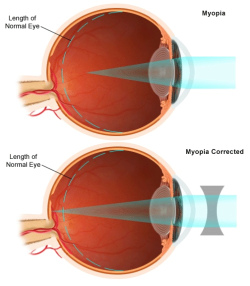|
What is Hyperopia?
Hyperopia or Farsightedness is a refractive error, which points to the need for spectacle prescription. You are farsighted when you have Hyperopia. This means you are sighted at far, or you see better at far and worse at near. 
Think of the eye as a camera system. The light from an object viewed is focused through the lens system of the eye (i.e., the cornea and crystalline lens) and the image is projected on the film of the eye (the retina, which is in the back of the eye). The brain takes the information of the retina, interprets the image, and so creates the perception of what we see. In the case of Farsightedness, the eyeball is too short and light from an object viewed focuses behind the retina instead of on the retina. In order to get the light rays to focus on the retina, convex (or plus) lenses are needed. See depiction: These convex or plus lenses can be either ophthalmic lenses for glasses or contact lenses, either soft or rigid. What symptoms can you expect with uncorrected Farsightedness?
In order to view the content, you must install the Adobe Flash Player. Please click here to get started.
Uncorrected Hyperopia may cause you to have the following symptoms:In the case of uncorrected farsightedness, the eye (or eyes) that remain uncorrected during the critical period of development (usually under six years of age) will not form adequate connections from the eye to the brain and will result in decreased vision. If you suspect your child is having problems seeing at near or you notice his or her eyes turn in toward the nose, consider taking him or her to the eye doctor. Early detection of Farsightedness may help to prevent the complications of Amblyopia in young children. In older children, the eyestrain caused by uncorrected Farsightedness may affect learning ability. Eyestrain can also contribute to red, irritated or tearing eyes. Low Hyperopia consists of an error of +2.00 diopters or less. Moderate Hyperopia includes a range of error from +2.25 to +5.00 diopters. High Hyperopia consists of an error over +5.00 diopters. How is Farsightedness diagnosed?
If you need to be in front of a computer 8-10 hours a day, you are subject to high near demand work, and your focusing muscles may not be strong enough to handle both the computer demand and your uncorrected farsightedness. A family history of Hyperopia, Amblyopia, or crossed eyes also increases the likelihood that you or your child with eye or vision problems will actually have these issues as well. The objective testing often requires, especially in younger patients, the use of dilating drops that temporarily immobilize the focusing muscles. In that way, your eye doctor can find a true amount of uncorrected Farsightedness without the interference of your focusing muscles. Once the drops wear off, however, the amount your doctor found during dilation will be too strong. This information is useful because it gives your eye doctor an idea of how hard your focusing muscles are working to help you see better. Your doctor may ask that you return in 6 months in order to see if he can increase your spectacle prescription in order to give you more of your needed prescription. How is Farsightedness treated?
As you can see, the treatment of Hyperopia is tailored for your individual needs, demands, age and symptoms. Consult with your eye doctor your concerns and complaints. Work with your eye care provider to reduce your focusing demand at near and use your eyes well together when reading. |




